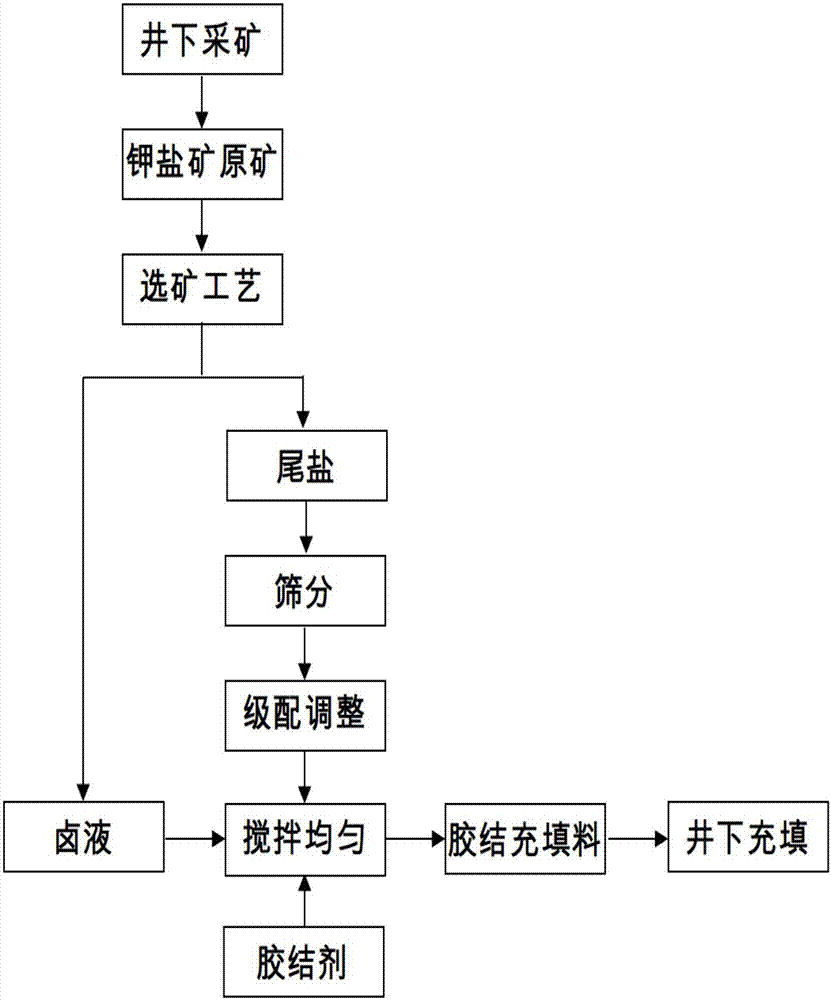Method for producing potassium salt mine cemented filling material by utilizing graded tailing salt
A technology for cementing and filling and potash mines, which is applied in the field of mining engineering, can solve the problems of tailings storage and the inability to recycle the brine, and achieve the effects of improving the anti-segregation ability, reducing the production cost and easy process control.
- Summary
- Abstract
- Description
- Claims
- Application Information
AI Technical Summary
Problems solved by technology
Method used
Image
Examples
Embodiment 1
[0023] The sodium chloride content of certain tail salt is 95%, and the maximum particle size is 9mm. Dry the tail salt to a moisture content of 0.6%, sieve it with a 4mm sieve, grind the +4mm tail salt to -0.15mm to 50%, and then mix it with the -4mm tail salt evenly for bone material. The magnesium chloride content in the brine is 32.79%, the potassium chloride content is 0.58%, the sodium chloride content is 1.08%, and the calcium chloride content is 0.13%. The cementing agent is lightly calcined magnesia powder, and the calcination conditions are as follows: a calcination temperature of 600°C, a holding time of 10 hours, and the calcined magnesia is ground to a -100 mesh content of 50%. The tailing salt is mixed with the brine and cementing agent according to the proportion tailing salt: brine: cementing agent = 63%: 35%: 2% and stirred evenly to prepare potash ore cemented filling. The initial fluidity of the produced potash ore cemented filling is 220mm, the fluidity i...
Embodiment 2
[0025] The sodium chloride content of certain tail salt is 95%, and the maximum particle size is 8mm. Dry the tailing salt to a moisture content of 0.8%, use a sieve with a size of 2.5mm to sieve, grind the tailing salt of +2.5mm until the tailing salt of -0.15mm is 45%, and then mix it with the tailing salt of -2.5mm evenly Used as aggregate. The magnesium chloride content in the brine is 32.23%, the potassium chloride content is 0.55%, the sodium chloride content is 1.0%, and the calcium chloride content is 0.12%. The binder is magnesium cement powder. The tailing salt is mixed with brine and cementing agent according to the proportion of tailing salt: brine: cementing agent = 60%: 36.5%: 3.5% and stirred evenly to prepare potash ore cemented filling. The initial fluidity of the produced potash cemented filling is 210mm, the fluidity is 170mm after 1 hour, and the fluidity is 150mm after 2 hours, and the compressive strength can reach 0.92MPa after 28 days of curing.
Embodiment 3
[0027] The sodium chloride content of certain tail salt is 95%, and the maximum particle size is 9mm. Dry the tail salt to a moisture content of 0.5%, use sieves with sizes of 2.5mm and 0.63mm to sieve, grind the tail salt of -2.5mm+0.63mm to -0.15mm to 44%, and then use +2.5 mm and -0.63mm tail salt are mixed evenly and used as aggregate. The magnesium chloride content in the brine is 33.0%, the potassium chloride content is 0.5%, the sodium chloride content is 1.0%, and the calcium chloride content is 0.11%. The cement is calcined dolomite powder that has been calcined in a high-temperature gas-fired shuttle kiln at 1400°C for 8 hours and ground to a particle size of -0.15mm to 45%. The tailing salt is mixed with brine and cementing agent according to the proportion of tailing salt: brine: cementing agent = 55%: 40%: 5% and stirred evenly to prepare potash ore cemented filling. The initial fluidity of the produced potash ore cemented filling is 230mm, the fluidity is 200mm...
PUM
| Property | Measurement | Unit |
|---|---|---|
| Liquidity | aaaaa | aaaaa |
| Liquidity | aaaaa | aaaaa |
| Liquidity | aaaaa | aaaaa |
Abstract
Description
Claims
Application Information
 Login to View More
Login to View More - R&D
- Intellectual Property
- Life Sciences
- Materials
- Tech Scout
- Unparalleled Data Quality
- Higher Quality Content
- 60% Fewer Hallucinations
Browse by: Latest US Patents, China's latest patents, Technical Efficacy Thesaurus, Application Domain, Technology Topic, Popular Technical Reports.
© 2025 PatSnap. All rights reserved.Legal|Privacy policy|Modern Slavery Act Transparency Statement|Sitemap|About US| Contact US: help@patsnap.com

